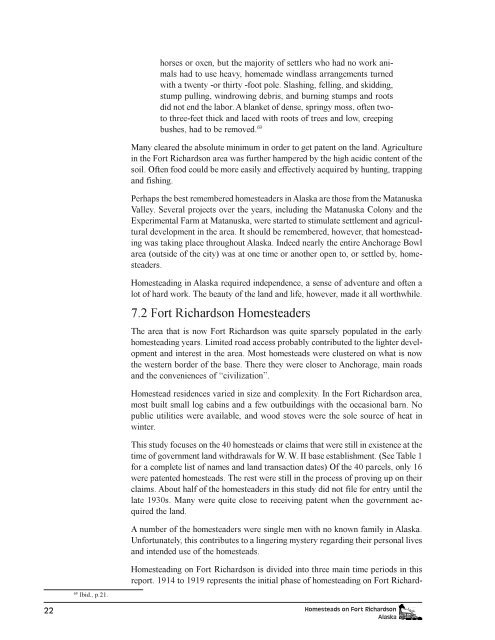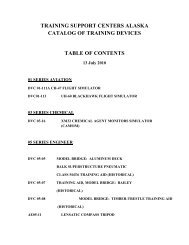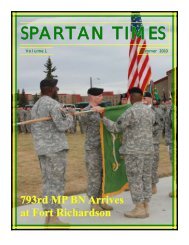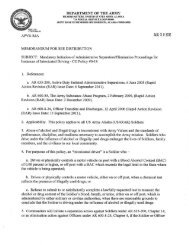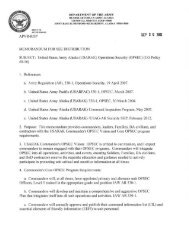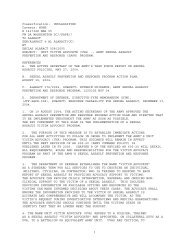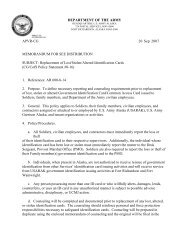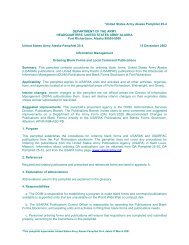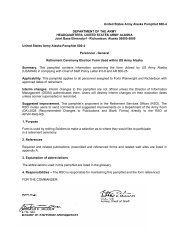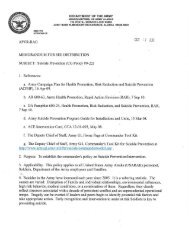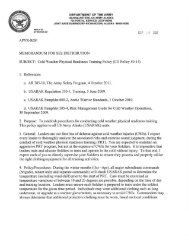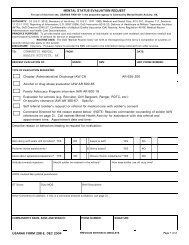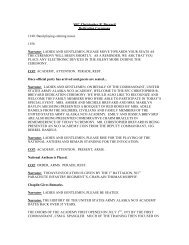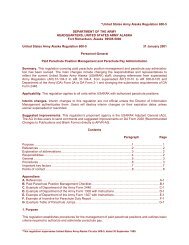Homesteads on Fort Richardson, Alaska - The USARAK Home Page ...
Homesteads on Fort Richardson, Alaska - The USARAK Home Page ...
Homesteads on Fort Richardson, Alaska - The USARAK Home Page ...
- No tags were found...
You also want an ePaper? Increase the reach of your titles
YUMPU automatically turns print PDFs into web optimized ePapers that Google loves.
horses or oxen, but the majority of settlers who had no work animalshad to use heavy, homemade windlass arrangements turnedwith a twenty -or thirty -foot pole. Slashing, felling, and skidding,stump pulling, windrowing debris, and burning stumps and rootsdid not end the labor. A blanket of dense, springy moss, often twotothree-feet thick and laced with roots of trees and low, creepingbushes, had to be removed. 69Many cleared the absolute minimum in order to get patent <strong>on</strong> the land. Agriculturein the <strong>Fort</strong> Richards<strong>on</strong> area was further hampered by the high acidic c<strong>on</strong>tent of thesoil. Often food could be more easily and effectively acquired by hunting, trappingand fishing.Perhaps the best remembered homesteaders in <strong>Alaska</strong> are those from the MatanuskaValley. Several projects over the years, including the Matanuska Col<strong>on</strong>y and theExperimental Farm at Matanuska, were started to stimulate settlement and agriculturaldevelopment in the area. It should be remembered, however, that homesteadingwas taking place throughout <strong>Alaska</strong>. Indeed nearly the entire Anchorage Bowlarea (outside of the city) was at <strong>on</strong>e time or another open to, or settled by, homesteaders.<strong>Home</strong>steading in <strong>Alaska</strong> required independence, a sense of adventure and often alot of hard work. <strong>The</strong> beauty of the land and life, however, made it all worthwhile.7.2 <strong>Fort</strong> Richards<strong>on</strong> <strong>Home</strong>steaders<strong>The</strong> area that is now <strong>Fort</strong> Richards<strong>on</strong> was quite sparsely populated in the earlyhomesteading years. Limited road access probably c<strong>on</strong>tributed to the lighter developmentand interest in the area. Most homesteads were clustered <strong>on</strong> what is nowthe western border of the base. <strong>The</strong>re they were closer to Anchorage, main roadsand the c<strong>on</strong>veniences of “civilizati<strong>on</strong>”.<strong>Home</strong>stead residences varied in size and complexity. In the <strong>Fort</strong> Richards<strong>on</strong> area,most built small log cabins and a few outbuildings with the occasi<strong>on</strong>al barn. Nopublic utilities were available, and wood stoves were the sole source of heat inwinter.This study focuses <strong>on</strong> the 40 homesteads or claims that were still in existence at thetime of government land withdrawals for W. W. II base establishment. (See Table 1for a complete list of names and land transacti<strong>on</strong> dates) Of the 40 parcels, <strong>on</strong>ly 16were patented homesteads. <strong>The</strong> rest were still in the process of proving up <strong>on</strong> theirclaims. About half of the homesteaders in this study did not file for entry until thelate 1930s. Many were quite close to receiving patent when the government acquiredthe land.A number of the homesteaders were single men with no known family in <strong>Alaska</strong>.Unfortunately, this c<strong>on</strong>tributes to a lingering mystery regarding their pers<strong>on</strong>al livesand intended use of the homesteads.<strong>Home</strong>steading <strong>on</strong> <strong>Fort</strong> Richards<strong>on</strong> is divided into three main time periods in thisreport. 1914 to 1919 represents the initial phase of homesteading <strong>on</strong> <strong>Fort</strong> Richard-69Ibid., p.21.22<str<strong>on</strong>g><strong>Home</strong>steads</str<strong>on</strong>g> <strong>on</strong> <strong>Fort</strong> Richards<strong>on</strong><strong>Alaska</strong>


